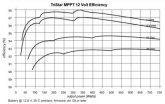ianganderton
Auckland, NZ
My current understanding has been to put solar panels in series to make the most of the efficiencies of higher voltages and lower amps
I’ve just come across this graph though that shows higher mppt efficiencies for lower voltages.

Are any efficiencies like this device specific? Is it swings and roundabouts cable efficiencies vs mppt efficiencies?
I’ve just come across this graph though that shows higher mppt efficiencies for lower voltages.

Are any efficiencies like this device specific? Is it swings and roundabouts cable efficiencies vs mppt efficiencies?


